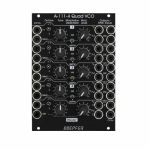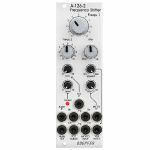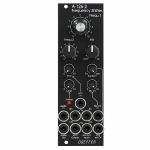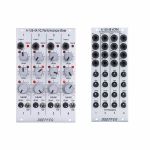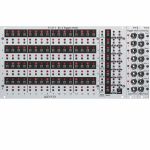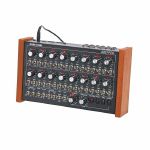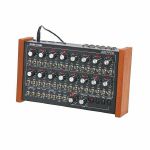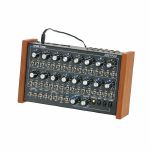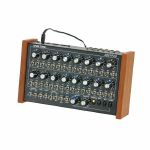100% Secure Shopping
Studio equipment
Our full range of studio equipment from all the leading equipment and software brands. Guaranteed fast delivery and low prices.
100% Secure Shopping
DJ equipment
Our full range of DJ equipment from all the leading equipment and software brands. Guaranteed fast delivery and low prices. Visit Juno DJ
Receive new release alerts for Doepfer
Filter
Stock
Equipment
Format
Featured
Price
Tags
Items 1 to 10 of 10 on page 1 of 1
Doepfer A-111-4 Quad Precision VCO Module (silver) (oscillator/quad synth module)
Cat: 671550 Rel: 29 Nov 17
VCO module featuring four precision oscillators - 18HP
Notes: A-111-4 contains four precision VCOs and has individual controls, inputs and outputs for each VCO available as well as a common control and output unit. After all the A-111-4 is very similar to four A-111-3 without LFO mode but built in output mixers for the three waveforms, and a master unit for all four VCOs.
Controls, inputs and outputs for each of the four VCOs:
- 1V/Octave CV input
- Octave switch (+1 / 0 / -1 octave)
- Tune control (range internally adjustable by jumpers: ~ 2 semitones / ~ 1 octave / ~ 4 octaves)
- Modulation CV input
- Modulation destination:
- Upper position: exponential frequency modulation (XM)lower position: linear frequency modulation (LM) or pulsewidth modulation of the rectangle (PM), selectable via internal jumper
- Frequency Modulation (FM) or Pulsewidth Modulation of the rectangle (PWM)
- Modulation intensity
- Triangle output
- Sawtooth output
- Rectangle output (about 50% without external PWM)
- Sync input (hard or soft sync internally selectable via jumper, CEM3340 hard sync type)
- Min. 10 octaves range (with appropriate external CV)
- CEM3340 based VCO (triangle core)
- Each VCO has it's own separate internal +/- power supply for each for best stability and the prevention of unwanted synchronisation of the VCOs
Controls, inputs and outputs of the master section:
- 1V/Octave CV input
- Octave switch (+1 / 0 / -1 octave)
- Tune control (range internally adjustable by jumpers: 2 semitones / 1 octave / 4 octaves)
- Frequency Modulation CV input (FM)
- FM intensity
- Triangle sum output
- Sawtooth sum output
- Rectangle sum output
- As soon as the single waveform output of a VCO is patched this waveform of the VCO in question is removed from the sum (this function can be turned off for each single output socket by means of solder bridges on the pc board, i.e. the sum contains then all signals independent of the patching of the single output)
- CV output (outputs the sum CV that is used to control all four VCOs)
- Bus CV (selectable via jumper)
Typical applications:
- Fat sounding monophonic VCO with the possibility to adjust any intervals
- Paraphonic patches in combination with the polyphonic CV interface A-190-5 (all four VCOs processed by one VCF/VCA)
- Full polyphonic patches in combination with the polyphonic CV interface A-190-5 and four complete VCF/VCA sections
- Complex VCO patches with up to four VCOs by means of the frequency modulation features (exponential an linear) and the sync functions
… Read moreControls, inputs and outputs for each of the four VCOs:
- 1V/Octave CV input
- Octave switch (+1 / 0 / -1 octave)
- Tune control (range internally adjustable by jumpers: ~ 2 semitones / ~ 1 octave / ~ 4 octaves)
- Modulation CV input
- Modulation destination:
- Upper position: exponential frequency modulation (XM)lower position: linear frequency modulation (LM) or pulsewidth modulation of the rectangle (PM), selectable via internal jumper
- Frequency Modulation (FM) or Pulsewidth Modulation of the rectangle (PWM)
- Modulation intensity
- Triangle output
- Sawtooth output
- Rectangle output (about 50% without external PWM)
- Sync input (hard or soft sync internally selectable via jumper, CEM3340 hard sync type)
- Min. 10 octaves range (with appropriate external CV)
- CEM3340 based VCO (triangle core)
- Each VCO has it's own separate internal +/- power supply for each for best stability and the prevention of unwanted synchronisation of the VCOs
Controls, inputs and outputs of the master section:
- 1V/Octave CV input
- Octave switch (+1 / 0 / -1 octave)
- Tune control (range internally adjustable by jumpers: 2 semitones / 1 octave / 4 octaves)
- Frequency Modulation CV input (FM)
- FM intensity
- Triangle sum output
- Sawtooth sum output
- Rectangle sum output
- As soon as the single waveform output of a VCO is patched this waveform of the VCO in question is removed from the sum (this function can be turned off for each single output socket by means of solder bridges on the pc board, i.e. the sum contains then all signals independent of the patching of the single output)
- CV output (outputs the sum CV that is used to control all four VCOs)
- Bus CV (selectable via jumper)
Typical applications:
- Fat sounding monophonic VCO with the possibility to adjust any intervals
- Paraphonic patches in combination with the polyphonic CV interface A-190-5 (all four VCOs processed by one VCF/VCA)
- Full polyphonic patches in combination with the polyphonic CV interface A-190-5 and four complete VCF/VCA sections
- Complex VCO patches with up to four VCOs by means of the frequency modulation features (exponential an linear) and the sync functions
out of stock $359.80
Doepfer A-111-4v Quad Precision VCO Vintage Edition Module (black) (oscillator/quad synth module)
Cat: 734878 Rel: 09 Jul 19
Quad precision VCO - 18HP
Notes: A-111-4 contains four precision VCOs and has individual controls, inputs and outputs for each VCO available as well as a common control and output unit. After all the A-111-4 is very similar to four A-111-3 without LFO mode but built in output mixers for the three waveforms, and a master unit for all four VCOs.
Controls, inputs and outputs for each of the four VCOs:
- 1V/Octave CV input
- Octave switch (+1 / 0 / -1 octave)
- Tune control (range internally adjustable by jumpers: ~ 2 semitones / ~ 1 octave / ~ 4 octaves)
- Modulation CV input
- Modulation destination: Upper position: exponential frequency modulation (XM) / Lower position: linear frequency modulation (LM) or pulsewidth modulation of the rectangle (PM), selectable via internal jumper
- Frequency Modulation (FM) or Pulsewidth Modulation of the rectangle (PWM)
- Modulation intensity
- Triangle output
- Sawtooth output
- Rectangle output (about 50% without external PWM)
- Sync input (hard or soft sync internally selectable via jumper, CEM3340 hard sync type)
- CEM3340 based VCO (triangle core)
- Each VCO has it's own separate internal +/- power supply for each for best stability and the prevention of unwanted synchronisation of the VCOs
Controls, inputs and outputs of the master section:
- 1V/Octave CV input
- Octave switch (+1 / 0 / -1 octave)
- Tune control (range internally adjustable by jumpers: 2 semitones / 1 octave / 4 octaves)
- Frequency Modulation CV input (FM)
- FM intensity
- Triangle sum output
- Sawtooth sum output
- Rectangle sum output
- As soon as the single waveform output of a VCO is patched this waveform of the VCO in question is removed from the sum (this function can be turned off for each single output socket by means of solder bridges on the pc board, i.e. the sum contains then all signals independent of the patching of the single output)
- CV output (outputs the sum CV that is used to control all four VCOs)
- Bus CV (via jumper, optional, please remove the bus jumper if this feature is not used to avoid unwanted frequency modulation as then the unused CV line of the bus works as a kind of antenna)
Typical applications:
- Fat sounding monophonic VCO with the possibility to adjust any intervals
- Paraphonic patches in combination with the polyphonic CV interface A-190-5 (all four VCOs processed by one VCF/VCA)
- Full polyphonic patches in combination with the polyphonic CV interface A-190-5 and four complete VCF/VCA sections
- Complex VCO patches with up to four VCOs by means of the frequency modulation features (exponential an linear) and the sync functions
… Read moreControls, inputs and outputs for each of the four VCOs:
- 1V/Octave CV input
- Octave switch (+1 / 0 / -1 octave)
- Tune control (range internally adjustable by jumpers: ~ 2 semitones / ~ 1 octave / ~ 4 octaves)
- Modulation CV input
- Modulation destination: Upper position: exponential frequency modulation (XM) / Lower position: linear frequency modulation (LM) or pulsewidth modulation of the rectangle (PM), selectable via internal jumper
- Frequency Modulation (FM) or Pulsewidth Modulation of the rectangle (PWM)
- Modulation intensity
- Triangle output
- Sawtooth output
- Rectangle output (about 50% without external PWM)
- Sync input (hard or soft sync internally selectable via jumper, CEM3340 hard sync type)
- CEM3340 based VCO (triangle core)
- Each VCO has it's own separate internal +/- power supply for each for best stability and the prevention of unwanted synchronisation of the VCOs
Controls, inputs and outputs of the master section:
- 1V/Octave CV input
- Octave switch (+1 / 0 / -1 octave)
- Tune control (range internally adjustable by jumpers: 2 semitones / 1 octave / 4 octaves)
- Frequency Modulation CV input (FM)
- FM intensity
- Triangle sum output
- Sawtooth sum output
- Rectangle sum output
- As soon as the single waveform output of a VCO is patched this waveform of the VCO in question is removed from the sum (this function can be turned off for each single output socket by means of solder bridges on the pc board, i.e. the sum contains then all signals independent of the patching of the single output)
- CV output (outputs the sum CV that is used to control all four VCOs)
- Bus CV (via jumper, optional, please remove the bus jumper if this feature is not used to avoid unwanted frequency modulation as then the unused CV line of the bus works as a kind of antenna)
Typical applications:
- Fat sounding monophonic VCO with the possibility to adjust any intervals
- Paraphonic patches in combination with the polyphonic CV interface A-190-5 (all four VCOs processed by one VCF/VCA)
- Full polyphonic patches in combination with the polyphonic CV interface A-190-5 and four complete VCF/VCA sections
- Complex VCO patches with up to four VCOs by means of the frequency modulation features (exponential an linear) and the sync functions
out of stock $435.49
Doepfer A-126-2 Frequency Shifter Eurorack Module (eurorack oscillator/phase shifter/pitch shifter/VCA module)
Cat: 847081 Rel: 17 Nov 21
Voltage Controlled Frequency Shifter II
Notes: Module A-126-2 is a fully analog frequency shifter for audio signals. A frequency shifter is an audio processing unit that shifts each frequency of the incoming audio signal by the same frequency. If the shifting frequency is e.g. 200Hz an incoming audio frequency of 1000 Hz becomes 1200 Hz, 2000Hz becomes 2200 Hz, 3000 Hz becomes 3200 Hz and so on. Pay attention that this is different from pitch shifting where all frequencies are shifted proportional (e.g. 1000>1200Hz, 2000>2400Hz, 3000>3600Hz) !
The frequency range of the internal quadrature VCO is about 8 octaves (about 20Hz ... 5kHz). If required an external quadrature VCO can be used.
The module is equipped with these controls, inputs and outputs:
Frequ. 1: first manual control of the shifting frequency (factory setting: coarse, range about 20Hz - 5 kHz)
Frequ. 2: second manual control of the shifting frequency (factory setting: fine)
by means of internal jumpers the sensitivity of Frequ.1 and 2 can be swapped (i.e. Frequ.1 = fine and Frequ.2 = coarse)
the relation between coarse and fine control is about 25:1 (corresponding to about 8 octaves to 1/3 octave)
FCV In (socket) and FCV (small control without knob): control voltage input with attenuator for the external voltage control of the shifting frequency
Mix: manual control of the up/down shift panning unit, fully CCW = down shift, fully CW = up shift, in between a mixture of down and up
Mix CV In (socket) and Mix CV (small control without knob): control voltage input with attenuator for the mixing unit for external voltage control of the up/down mixing
Audio In (socket), Level (small control without knob) and Overload (LED): audio input with attenuator, typ. audio in level = 1Vpp, the level control has to be adjusted so that the overload LED just begins to light up a bit, when the LED is fully on clipping/distortion occurs, when the LED is permanently off the input level is too low and the signal-to-noise ratio increases
Audio Out (socket): audio output of the frequency shifter
Squelch (small control without knob): controls the squelch function: fully CCW (Env.) the output VCA is controlled by the envelope signal, which is derived from the audio input signal, fully CW (open) the output VCA is permanently open (no squelch function), in between the squelch intensity can be adjusted
Quadrature VCO Outputs (sockets Sin and Cos): outputs of the internal quadrature oscillator, about 12Vpp level (+6V/-6V)
Ext. Inputs Sin and Cos (sockets): required when an external quadrature VCO (e.g. A-143-9 with a wider frequency range or A-110-4 with thru zero feature or A-110-6 with different waveforms) is used instead of the internal quadrature VCO, the levels of the external VCO should be about 10Vpp (8...10Vpp are OK) and the signals have to be symmetrical around zero Volts, the sockets are normalled to the internal quadrature VCO (i.e. the sockets are equipped with switching contacts that interrupt the internal connection as soon as a plug inserted)
VCA ext. CV (socket): used when an external control voltage (e.g. from an envelope generator) should be used to control the output VCA instead of the internal squelch unit, the socket is normalled to the output of the squelch control (i.e. the socket is equipped with a switching contact that interrupts the internal squelch connection as soon as a plug inserted). From about +8V external control voltage the VCA is fully open.
Internal terminals (pin headers, e.g. for a DIY breakout module):
envelope follower output
dome filter output 1
dome filter output 2
ring modulator 1 output
ring modulator 2 output
Up shift output
Down shift output
… Read moreThe frequency range of the internal quadrature VCO is about 8 octaves (about 20Hz ... 5kHz). If required an external quadrature VCO can be used.
The module is equipped with these controls, inputs and outputs:
Frequ. 1: first manual control of the shifting frequency (factory setting: coarse, range about 20Hz - 5 kHz)
Frequ. 2: second manual control of the shifting frequency (factory setting: fine)
by means of internal jumpers the sensitivity of Frequ.1 and 2 can be swapped (i.e. Frequ.1 = fine and Frequ.2 = coarse)
the relation between coarse and fine control is about 25:1 (corresponding to about 8 octaves to 1/3 octave)
FCV In (socket) and FCV (small control without knob): control voltage input with attenuator for the external voltage control of the shifting frequency
Mix: manual control of the up/down shift panning unit, fully CCW = down shift, fully CW = up shift, in between a mixture of down and up
Mix CV In (socket) and Mix CV (small control without knob): control voltage input with attenuator for the mixing unit for external voltage control of the up/down mixing
Audio In (socket), Level (small control without knob) and Overload (LED): audio input with attenuator, typ. audio in level = 1Vpp, the level control has to be adjusted so that the overload LED just begins to light up a bit, when the LED is fully on clipping/distortion occurs, when the LED is permanently off the input level is too low and the signal-to-noise ratio increases
Audio Out (socket): audio output of the frequency shifter
Squelch (small control without knob): controls the squelch function: fully CCW (Env.) the output VCA is controlled by the envelope signal, which is derived from the audio input signal, fully CW (open) the output VCA is permanently open (no squelch function), in between the squelch intensity can be adjusted
Quadrature VCO Outputs (sockets Sin and Cos): outputs of the internal quadrature oscillator, about 12Vpp level (+6V/-6V)
Ext. Inputs Sin and Cos (sockets): required when an external quadrature VCO (e.g. A-143-9 with a wider frequency range or A-110-4 with thru zero feature or A-110-6 with different waveforms) is used instead of the internal quadrature VCO, the levels of the external VCO should be about 10Vpp (8...10Vpp are OK) and the signals have to be symmetrical around zero Volts, the sockets are normalled to the internal quadrature VCO (i.e. the sockets are equipped with switching contacts that interrupt the internal connection as soon as a plug inserted)
VCA ext. CV (socket): used when an external control voltage (e.g. from an envelope generator) should be used to control the output VCA instead of the internal squelch unit, the socket is normalled to the output of the squelch control (i.e. the socket is equipped with a switching contact that interrupts the internal squelch connection as soon as a plug inserted). From about +8V external control voltage the VCA is fully open.
Internal terminals (pin headers, e.g. for a DIY breakout module):
envelope follower output
dome filter output 1
dome filter output 2
ring modulator 1 output
ring modulator 2 output
Up shift output
Down shift output
1 in stock $322.47
Click for better price!
or call +44 20 7424 1960
quote 847081
quote 847081
Doepfer A-126-2v Frequency Shifter Vintage Edition Module (black) (oscillator/phase shifter/pitch shifter/VCA synth module)
Cat: 847083 Rel: 17 Nov 21
Voltage Controlled Frequency Shifter II
Notes: 'Vintage' black panel version of Doepfer's updated frequency shifter module, offering weird and wonderful effects by shifting all frequencies by a fixed amount. Unique sound, not to be confused with pitch shifting.
Supplier's Notes:
Module A-126-2 is a fully analog frequency shifter for audio signals. A frequency shifter is an audio processing unit that shifts each frequency of the incoming audio signal by the same frequency. If the shifting frequency is e.g. 200Hz an incoming audio frequency of 1000 Hz becomes 1200 Hz, 2000Hz becomes 2200 Hz, 3000 Hz becomes 3200 Hz and so on. Pay attention that this is different from pitch shifting where all frequencies are shifted proportional (e.g. 1000>1200Hz, 2000>2400Hz, 3000>3600Hz) !
The frequency range of the internal quadrature VCO is about 8 octaves (about 20Hz ... 5kHz). If required an external quadrature VCO can be used.
The module is equipped with these controls, inputs and outputs:
Frequ. 1: first manual control of the shifting frequency (factory setting: coarse, range about 20Hz - 5 kHz)
Frequ. 2: second manual control of the shifting frequency (factory setting: fine)
by means of internal jumpers the sensitivity of Frequ.1 and 2 can be swapped (i.e. Frequ.1 = fine and Frequ.2 = coarse)
the relation between coarse and fine control is about 25:1 (corresponding to about 8 octaves to 1/3 octave)
FCV In (socket) and FCV (small control without knob): control voltage input with attenuator for the external voltage control of the shifting frequency
Mix: manual control of the up/down shift panning unit, fully CCW = down shift, fully CW = up shift, in between a mixture of down and up
Mix CV In (socket) and Mix CV (small control without knob): control voltage input with attenuator for the mixing unit for external voltage control of the up/down mixing
Audio In (socket), Level (small control without knob) and Overload (LED): audio input with attenuator, typ. audio in level = 1Vpp, the level control has to be adjusted so that the overload LED just begins to light up a bit, when the LED is fully on clipping/distortion occurs, when the LED is permanently off the input level is too low and the signal-to-noise ratio increases
Audio Out (socket): audio output of the frequency shifter
Squelch (small control without knob): controls the squelch function: fully CCW (Env.) the output VCA is controlled by the envelope signal, which is derived from the audio input signal, fully CW (open) the output VCA is permanently open (no squelch function), in between the squelch intensity can be adjusted
Quadrature VCO Outputs (sockets Sin and Cos): outputs of the internal quadrature oscillator, about 12Vpp level (+6V/-6V)
Ext. Inputs Sin and Cos (sockets): required when an external quadrature VCO (e.g. A-143-9 with a wider frequency range or A-110-4 with thru zero feature or A-110-6 with different waveforms) is used instead of the internal quadrature VCO, the levels of the external VCO should be about 10Vpp (8...10Vpp are OK) and the signals have to be symmetrical around zero Volts, the sockets are normalled to the internal quadrature VCO (i.e. the sockets are equipped with switching contacts that interrupt the internal connection as soon as a plug inserted)
VCA ext. CV (socket): used when an external control voltage (e.g. from an envelope generator) should be used to control the output VCA instead of the internal squelch unit, the socket is normalled to the output of the squelch control (i.e. the socket is equipped with a switching contact that interrupts the internal squelch connection as soon as a plug inserted). From about +8V external control voltage the VCA is fully open.
Internal terminals (pin headers, e.g. for a DIY breakout module):
envelope follower output
dome filter output 1
dome filter output 2
ring modulator 1 output
ring modulator 2 output
Up shift output
Down shift output
… Read moreSupplier's Notes:
Module A-126-2 is a fully analog frequency shifter for audio signals. A frequency shifter is an audio processing unit that shifts each frequency of the incoming audio signal by the same frequency. If the shifting frequency is e.g. 200Hz an incoming audio frequency of 1000 Hz becomes 1200 Hz, 2000Hz becomes 2200 Hz, 3000 Hz becomes 3200 Hz and so on. Pay attention that this is different from pitch shifting where all frequencies are shifted proportional (e.g. 1000>1200Hz, 2000>2400Hz, 3000>3600Hz) !
The frequency range of the internal quadrature VCO is about 8 octaves (about 20Hz ... 5kHz). If required an external quadrature VCO can be used.
The module is equipped with these controls, inputs and outputs:
Frequ. 1: first manual control of the shifting frequency (factory setting: coarse, range about 20Hz - 5 kHz)
Frequ. 2: second manual control of the shifting frequency (factory setting: fine)
by means of internal jumpers the sensitivity of Frequ.1 and 2 can be swapped (i.e. Frequ.1 = fine and Frequ.2 = coarse)
the relation between coarse and fine control is about 25:1 (corresponding to about 8 octaves to 1/3 octave)
FCV In (socket) and FCV (small control without knob): control voltage input with attenuator for the external voltage control of the shifting frequency
Mix: manual control of the up/down shift panning unit, fully CCW = down shift, fully CW = up shift, in between a mixture of down and up
Mix CV In (socket) and Mix CV (small control without knob): control voltage input with attenuator for the mixing unit for external voltage control of the up/down mixing
Audio In (socket), Level (small control without knob) and Overload (LED): audio input with attenuator, typ. audio in level = 1Vpp, the level control has to be adjusted so that the overload LED just begins to light up a bit, when the LED is fully on clipping/distortion occurs, when the LED is permanently off the input level is too low and the signal-to-noise ratio increases
Audio Out (socket): audio output of the frequency shifter
Squelch (small control without knob): controls the squelch function: fully CCW (Env.) the output VCA is controlled by the envelope signal, which is derived from the audio input signal, fully CW (open) the output VCA is permanently open (no squelch function), in between the squelch intensity can be adjusted
Quadrature VCO Outputs (sockets Sin and Cos): outputs of the internal quadrature oscillator, about 12Vpp level (+6V/-6V)
Ext. Inputs Sin and Cos (sockets): required when an external quadrature VCO (e.g. A-143-9 with a wider frequency range or A-110-4 with thru zero feature or A-110-6 with different waveforms) is used instead of the internal quadrature VCO, the levels of the external VCO should be about 10Vpp (8...10Vpp are OK) and the signals have to be symmetrical around zero Volts, the sockets are normalled to the internal quadrature VCO (i.e. the sockets are equipped with switching contacts that interrupt the internal connection as soon as a plug inserted)
VCA ext. CV (socket): used when an external control voltage (e.g. from an envelope generator) should be used to control the output VCA instead of the internal squelch unit, the socket is normalled to the output of the squelch control (i.e. the socket is equipped with a switching contact that interrupts the internal squelch connection as soon as a plug inserted). From about +8V external control voltage the VCA is fully open.
Internal terminals (pin headers, e.g. for a DIY breakout module):
envelope follower output
dome filter output 1
dome filter output 2
ring modulator 1 output
ring modulator 2 output
Up shift output
Down shift output
2 in stock $324.35
Doepfer A-135-4A/B VC Performance Mixer Input & Control Modules (single) (mixer/panning/quad/expander synth module)
Cat: 671608 Rel: 29 Nov 17
Voltage controllable performance mixer module package
Notes: Series A-135-4 contains several modules which are used to built a voltage controlled performance mixer. The modules of the A-135-4 series can be combined with the (non voltage controlled) mixer modules A-138o/p.
A-135-4A:
A-135-4A is the main module. It is very similar to module A-138p, but with voltage control for all parameters (except gain). Also the front panels of A-135-4A and A-138p are very similar. The only difference are the additional LEDs which are used to display the magnitudes of all voltage controlled parameters. This is necessary because the positions of the manual controls do not necessarily correspond to the resulting parameter value because these are composed by both the manual controls and the applied external control voltages (via A-135-4B). Without LEDs one would be left in the dark in regard to the actual parameter value.
A-135-4A contains four high quality voltage controlled amplifiers (VCA) for each channel: one for the main level, two for panorama left/right and one for aux. The control scales for all parameters are linear. Altogether 16 VCAs are included in the module. High end linear VCAs manufactured by Curtis/USA are used (CEM3381). The 16 LEDs display roughly the amplification of the VCA in question.
Module A-138o is used as output module for the A-135-4A. A-135-4A and A-138p can be connected together to the same A-138o to obtain e.g. four fully voltage controlled channels (A-135-4A) and four manually controlled channels (A-138p).
A-135-4B:
This module is used to route the 16 external control voltage to the main module A-135-4A. These control voltages are available for each channel:
- Level (main loudness)
- Panorama
- Aux
- Mute
Each control voltage has an input socket and a polarizer control available (the polarizer function is described more detailed on the A-138c info page). That way it's possible to adjust the depth and polarity of the external control voltage which affects the parameter in question. If the same CV (e.g. LFO or ADSR) is used e.g. for two panorama control inputs the result may be the opposite if the polarizers are adjusted accordingly (i.e. one positive and the other negative). The external control voltage is added to the voltage that is generated by the manual control on the A-135-4A main module. The sum of both voltages is used to control the VCA in question and is displayed with the corresponding LED on the A-135-4A module. The picture on the left side below shows one channel of A-135-4A/B as block diagram.
The mute CV input works in principle in the same way as the level CV input but with reverse polarity and higher sensitivity (about factor -2). Typically, the mute polarizer control is adjusted fully CW. Then a (gate) voltage of ~ +2.5V or more fully mutes the channel in question. If the mute function is not used the mute CV input can be used as a second CV input for level (with twice the sensitivity and inverted polarity compared to the normal level CV input).
A-135-4A and A-135-4B are connected internally via a 20 pin ribbon cable. The cable can be longer so that the CV input module A-135-4B needs not to be mounted next to the main module A-135-4A (e.g. to the row above or below).
Modules A-135-4A and A-135-4B are available only as a module combo because the single operation of each module does not make sense!
… Read moreA-135-4A:
A-135-4A is the main module. It is very similar to module A-138p, but with voltage control for all parameters (except gain). Also the front panels of A-135-4A and A-138p are very similar. The only difference are the additional LEDs which are used to display the magnitudes of all voltage controlled parameters. This is necessary because the positions of the manual controls do not necessarily correspond to the resulting parameter value because these are composed by both the manual controls and the applied external control voltages (via A-135-4B). Without LEDs one would be left in the dark in regard to the actual parameter value.
A-135-4A contains four high quality voltage controlled amplifiers (VCA) for each channel: one for the main level, two for panorama left/right and one for aux. The control scales for all parameters are linear. Altogether 16 VCAs are included in the module. High end linear VCAs manufactured by Curtis/USA are used (CEM3381). The 16 LEDs display roughly the amplification of the VCA in question.
Module A-138o is used as output module for the A-135-4A. A-135-4A and A-138p can be connected together to the same A-138o to obtain e.g. four fully voltage controlled channels (A-135-4A) and four manually controlled channels (A-138p).
A-135-4B:
This module is used to route the 16 external control voltage to the main module A-135-4A. These control voltages are available for each channel:
- Level (main loudness)
- Panorama
- Aux
- Mute
Each control voltage has an input socket and a polarizer control available (the polarizer function is described more detailed on the A-138c info page). That way it's possible to adjust the depth and polarity of the external control voltage which affects the parameter in question. If the same CV (e.g. LFO or ADSR) is used e.g. for two panorama control inputs the result may be the opposite if the polarizers are adjusted accordingly (i.e. one positive and the other negative). The external control voltage is added to the voltage that is generated by the manual control on the A-135-4A main module. The sum of both voltages is used to control the VCA in question and is displayed with the corresponding LED on the A-135-4A module. The picture on the left side below shows one channel of A-135-4A/B as block diagram.
The mute CV input works in principle in the same way as the level CV input but with reverse polarity and higher sensitivity (about factor -2). Typically, the mute polarizer control is adjusted fully CW. Then a (gate) voltage of ~ +2.5V or more fully mutes the channel in question. If the mute function is not used the mute CV input can be used as a second CV input for level (with twice the sensitivity and inverted polarity compared to the normal level CV input).
A-135-4A and A-135-4B are connected internally via a 20 pin ribbon cable. The cable can be longer so that the CV input module A-135-4B needs not to be mounted next to the main module A-135-4A (e.g. to the row above or below).
Modules A-135-4A and A-135-4B are available only as a module combo because the single operation of each module does not make sense!
out of stock $375.36
Doepfer A-157-1/2 8x16 Trigger Sequencer Matrix Module Set 1/2/3 (drum/sequencer/expander module)
Cat: 745786 Rel: 09 Sep 19
8-channel, 16-step-button step sequencer with breakout modules - 50HP
Notes: A-157 is a trigger sequencer subsystem that generates eight trigger signals controlled by a 8x16 LED/button matrix (some customers call it "Miniature Schaltwerk" as it is based on the same matrix as the no longer available Schaltwerk).
The subsystem contains three modules:
A-157-1: 8 x 16 LED/button matrix and function addressing buttons/LEDs
A-157-2: Trigger Output module
A-157-3: Control Inputs module
The LED/button matrix module A-157-1 is the core of the subsystem. It is used to set or reset the trigger event on each of the 16 steps of each of the 8 rows. In addition the buttons and LEDs of the matrix are used for other functions too (like setting the first and last step of each row or addressing the preset memory).
The Trigger Output module A-157-2 outputs the 8 trigger signals and has an LED display for each trigger available.
The Control Inputs module A-157-3 has manual controls and trigger inputs available for the basic control functions start, stop, reset and clock. In addition four functions inputs are available which will be used in future firmware versions to assign these inputs to special functions (e.g. shifting a row left or right by means of an external gate/trigger signal or a second set of start, stop, reset and clock for individual rows).
… Read moreThe subsystem contains three modules:
A-157-1: 8 x 16 LED/button matrix and function addressing buttons/LEDs
A-157-2: Trigger Output module
A-157-3: Control Inputs module
The LED/button matrix module A-157-1 is the core of the subsystem. It is used to set or reset the trigger event on each of the 16 steps of each of the 8 rows. In addition the buttons and LEDs of the matrix are used for other functions too (like setting the first and last step of each row or addressing the preset memory).
The Trigger Output module A-157-2 outputs the 8 trigger signals and has an LED display for each trigger available.
The Control Inputs module A-157-3 has manual controls and trigger inputs available for the basic control functions start, stop, reset and clock. In addition four functions inputs are available which will be used in future firmware versions to assign these inputs to special functions (e.g. shifting a row left or right by means of an external gate/trigger signal or a second set of start, stop, reset and clock for individual rows).
out of stock $429.27
Doepfer Dark Time 2x8 Analogue Sequencer With CV/Gate/USB/MIDI Interface (red LED version, supplied with 2 pin Euro plug) (analogue sequencer)
Cat: 427842 Rel: 14 Jun 11
MIDI & USB analogue sequencer with red LEDs (240V only)
Notes: Dark Time is an 2 x8 steps analog sequencer with CV/Gate, USB and Midi interface. It is planned in the first place as an add-on for the Dark Energy but may be used even in combination with other Midi, USB or CV/Gate equipment too.
Features overview
two rows with 8 controls each
for each step:
- rotary control (same knob type as Dark Energy)
- red LED
- three-position switch On/Off/Skip
On = trigger signal is active for this step
Off = no trigger for this step
Skip = step is skipped
- three-position switch Stop/Continue/Jump
Stop = sequence stops here
Continue = sequence continues
Jump/Reset:
If only one of the 16 toggle switches is in the Jump position a Reset is carried out (i.e. sequence jumps to stage 1)
If two or more of the switches are in the Jump position the sequence jumps to the next step with the switch in the Jump position and then continues from this position (until another step with the switch in the Jump position is reached and then the same procedure is carried out again)
several operating modes:
1x16 (i.e. the two rows are daisy-chained)
2x8 (i.e. both rows run in parallel)
1-8 Combi (lower row set individual gate lenght of the upper row)
several running directions:
forward
backward
random
CV scaling: 1V/Octave standard (note: not suitable to control devices with Hz/V scale !)
several voltage / tuning ranges: 1V, 2V, 5V (corresponding to 1/2/5 octaves)
gate voltage 0/+5V (please refer to the remarks below concerning devices with S-Trigger or Korg MS10/MS20)
for units manufactured later than early 2012 (from serial number 120240) the output voltage for Gate/Clock/Reset/Start-Stop can be set to +12V by means of an internal jumper (the corresponding interface boards are marked V2/2011 or V3/2012). The following document describes the modification procedure in detail: Dark_Time_12V_Gate.pdf
if you own a unit manufactured before 2012 (serial number 120239 or less) the following technical document describes how to modify the unit for +12V level of the Gate/Clock/Reset/Start-Stop outputs: Dark_Time_12V_and_5V_Gate_Voltage_Modifikation.pdf
quantization on/off/custom scale (custom scale not yet available in the first firmware version)
when quantization is "off" the resolution is still 10 bit (i.e. 1024 steps over the full rotating range of each potentiometer), from this the term "quantization off" is not fully correct, with quantization "on" the resolution is 13/25/61 steps for 1/2/5 octaves
transpose via switch (-1/0/+1 octave), Midi/USB or external CV input
timing control, selected by a three position switch:
internal via built-in clock oscillator with frequency and pulsewidth controls
external via Midi/USB
external via analog clock/start/stop
analog interface for CV/gate/clock/Start-Stop (inputs and outputs, monophonic 3.5 mm miniature jack sockets)
Midi interface
USB interface (power supply via USB is not possible)
optically adapted to Dark Energy (same knobs, same depth and height, same wooden side plates and so on)
Powered via external power supply (12V AC/min. 400mA) for 230V
powering the device via USB is not possible, because the analog circuits require a dual voltage (+/-12V).
Additional remarks and specs:
for devices with S-Trigger inputs (e.g. Moog) or the Korg synthesizers MS-10/MS-20 a special S-Trig cable is required to connect the gate output of the Dark Time to the Gate/S-Trig input of the synth, details on the FAQ page of our website. You find the price of the special cable in our price list in the accessories section.
Dark Time cannot be used to control synthesizers which use the Hz/V standard for the pitch CV (unless the quantization of the Dark Time is not used). Only for the Korg MS-10 and MS-20 there is a solution to use 1V/Oct control voltage. A corresponding note can be found on our FAQ page: Controlling Synthesizers with Hz/V standard
Distance between the knobs (center - center): ~ 25 mm, diameter of the knobs: ~ 16 mm
Distance between the toggle switches (center - center): ~ 12.5 mm
Distance between knobs and switches (center - center): ~ 20 mm
The metal case is made of 1 mm steel, black coated with white printing
Overall dimensions: about 248 x 145 x 75 mm
Dimension of the metal case only (without side plates and knobs): about 223 x 135 x 55 mm
Side plates dimensions: about 145 x 65 x 12.5 mm (same as Dark Energy)
Weight: about 1.5 kg (without power supply)
The wooden side plates can be removed if desired. They are mounted by means of two screws to the metal box. The holes in the metal box can be used also to mount several devices together (e.g. with common wooden side plates on both ends) or to mount the Dark Time to one or two Dark Energy.
The device can be positioned horizontal (desk top) or vertical
These parts are included: power supply (12V AC/min. 400mA) for 230V mains voltage with European mains plug, one USB cable (type A-B, 2 m length) and four A-100 patch cables
For the power supply a low voltage DC socket with 5.5 mm outer diameter and 2.1 mm inner diameter is used (even 2.5 mm will work)
Powering the device via USB is not possible, because the analog circuits require a dual voltage (+/-12V).
… Read moreFeatures overview
two rows with 8 controls each
for each step:
- rotary control (same knob type as Dark Energy)
- red LED
- three-position switch On/Off/Skip
On = trigger signal is active for this step
Off = no trigger for this step
Skip = step is skipped
- three-position switch Stop/Continue/Jump
Stop = sequence stops here
Continue = sequence continues
Jump/Reset:
If only one of the 16 toggle switches is in the Jump position a Reset is carried out (i.e. sequence jumps to stage 1)
If two or more of the switches are in the Jump position the sequence jumps to the next step with the switch in the Jump position and then continues from this position (until another step with the switch in the Jump position is reached and then the same procedure is carried out again)
several operating modes:
1x16 (i.e. the two rows are daisy-chained)
2x8 (i.e. both rows run in parallel)
1-8 Combi (lower row set individual gate lenght of the upper row)
several running directions:
forward
backward
random
CV scaling: 1V/Octave standard (note: not suitable to control devices with Hz/V scale !)
several voltage / tuning ranges: 1V, 2V, 5V (corresponding to 1/2/5 octaves)
gate voltage 0/+5V (please refer to the remarks below concerning devices with S-Trigger or Korg MS10/MS20)
for units manufactured later than early 2012 (from serial number 120240) the output voltage for Gate/Clock/Reset/Start-Stop can be set to +12V by means of an internal jumper (the corresponding interface boards are marked V2/2011 or V3/2012). The following document describes the modification procedure in detail: Dark_Time_12V_Gate.pdf
if you own a unit manufactured before 2012 (serial number 120239 or less) the following technical document describes how to modify the unit for +12V level of the Gate/Clock/Reset/Start-Stop outputs: Dark_Time_12V_and_5V_Gate_Voltage_Modifikation.pdf
quantization on/off/custom scale (custom scale not yet available in the first firmware version)
when quantization is "off" the resolution is still 10 bit (i.e. 1024 steps over the full rotating range of each potentiometer), from this the term "quantization off" is not fully correct, with quantization "on" the resolution is 13/25/61 steps for 1/2/5 octaves
transpose via switch (-1/0/+1 octave), Midi/USB or external CV input
timing control, selected by a three position switch:
internal via built-in clock oscillator with frequency and pulsewidth controls
external via Midi/USB
external via analog clock/start/stop
analog interface for CV/gate/clock/Start-Stop (inputs and outputs, monophonic 3.5 mm miniature jack sockets)
Midi interface
USB interface (power supply via USB is not possible)
optically adapted to Dark Energy (same knobs, same depth and height, same wooden side plates and so on)
Powered via external power supply (12V AC/min. 400mA) for 230V
powering the device via USB is not possible, because the analog circuits require a dual voltage (+/-12V).
Additional remarks and specs:
for devices with S-Trigger inputs (e.g. Moog) or the Korg synthesizers MS-10/MS-20 a special S-Trig cable is required to connect the gate output of the Dark Time to the Gate/S-Trig input of the synth, details on the FAQ page of our website. You find the price of the special cable in our price list in the accessories section.
Dark Time cannot be used to control synthesizers which use the Hz/V standard for the pitch CV (unless the quantization of the Dark Time is not used). Only for the Korg MS-10 and MS-20 there is a solution to use 1V/Oct control voltage. A corresponding note can be found on our FAQ page: Controlling Synthesizers with Hz/V standard
Distance between the knobs (center - center): ~ 25 mm, diameter of the knobs: ~ 16 mm
Distance between the toggle switches (center - center): ~ 12.5 mm
Distance between knobs and switches (center - center): ~ 20 mm
The metal case is made of 1 mm steel, black coated with white printing
Overall dimensions: about 248 x 145 x 75 mm
Dimension of the metal case only (without side plates and knobs): about 223 x 135 x 55 mm
Side plates dimensions: about 145 x 65 x 12.5 mm (same as Dark Energy)
Weight: about 1.5 kg (without power supply)
The wooden side plates can be removed if desired. They are mounted by means of two screws to the metal box. The holes in the metal box can be used also to mount several devices together (e.g. with common wooden side plates on both ends) or to mount the Dark Time to one or two Dark Energy.
The device can be positioned horizontal (desk top) or vertical
These parts are included: power supply (12V AC/min. 400mA) for 230V mains voltage with European mains plug, one USB cable (type A-B, 2 m length) and four A-100 patch cables
For the power supply a low voltage DC socket with 5.5 mm outer diameter and 2.1 mm inner diameter is used (even 2.5 mm will work)
Powering the device via USB is not possible, because the analog circuits require a dual voltage (+/-12V).
out of stock $408.54
Doepfer Dark Time MIDI/USB Analogue Sequencer (red LED version, supplied with 2 pin Euro plug) (B-STOCK) (MIDI/USB sequencer)
Cat: 926166 Rel: 01 Jan 90
B-STOCK: Original box damaged, product is in different packagaing but in perfect working order
Notes: ***B-STOCK: Original box damaged, product is in different packagaing but in perfect working order***
Dark Time is an 2x8 step analogue sequencer with CV/Gate, USB and MIDI interface. It is intended as an add-on for the Dark Energy but may be used in combination with other MIDI, USB or CV/Gate equipment too.
… Read moreDark Time is an 2x8 step analogue sequencer with CV/Gate, USB and MIDI interface. It is intended as an add-on for the Dark Energy but may be used in combination with other MIDI, USB or CV/Gate equipment too.
out of stock $365.41
Doepfer Dark Time MIDI/USB Analogue Sequencer (white & blue LED version, supplied with 2 pin Euro plug) (MIDI/USB sequencer)
Cat: 755439 Rel: 12 Nov 19
MIDI/USB analogue sequencer with white/blue LEDs (240V only)
Notes: Iconic analogue step sequencer from modular innovators Doepfer. Compatible with all MIDI or CV/gate synths, allowing a huge range of programming and sequencing options, plus real-time tweaking. A firm Juno favourite.
Supplier's notes:
Dark Time is an 2x8 step analogue sequencer with CV/Gate, USB and MIDI interface. It is intended as an add-on for the Dark Energy but may be used in combination with other MIDI, USB or CV/Gate equipment too.
… Read moreSupplier's notes:
Dark Time is an 2x8 step analogue sequencer with CV/Gate, USB and MIDI interface. It is intended as an add-on for the Dark Energy but may be used in combination with other MIDI, USB or CV/Gate equipment too.
out of stock $447.94
Doepfer Dark Time MIDI/USB Analogue Sequencer (white & blue LED version, supplied with 2 pin Euro plug) (B-STOCK) (MIDI/USB sequencer)
Cat: 926156 Rel: 01 Jan 90
B-STOCK: Original box damaged, product is in different packagaing but is in perfect working order
Notes: ***B-STOCK: Original box damaged, product is in different packagaing but is in perfect working order***
Iconic analogue step sequencer from modular innovators Doepfer. Compatible with all MIDI or CV/gate synths, allowing a huge range of programming and sequencing options, plus real-time tweaking. A firm Juno favourite.
Supplier's notes:
Dark Time is an 2x8 step analogue sequencer with CV/Gate, USB and MIDI interface. It is intended as an add-on for the Dark Energy but may be used in combination with other MIDI, USB or CV/Gate equipment too.
… Read moreIconic analogue step sequencer from modular innovators Doepfer. Compatible with all MIDI or CV/gate synths, allowing a huge range of programming and sequencing options, plus real-time tweaking. A firm Juno favourite.
Supplier's notes:
Dark Time is an 2x8 step analogue sequencer with CV/Gate, USB and MIDI interface. It is intended as an add-on for the Dark Energy but may be used in combination with other MIDI, USB or CV/Gate equipment too.
out of stock $440.89
Items 1 to 10 of 10 on page 1 of 1




